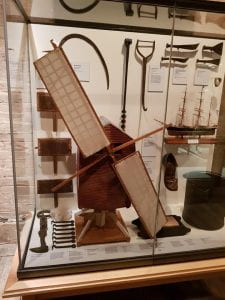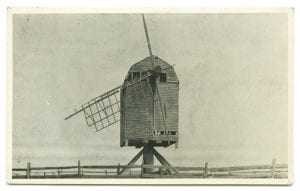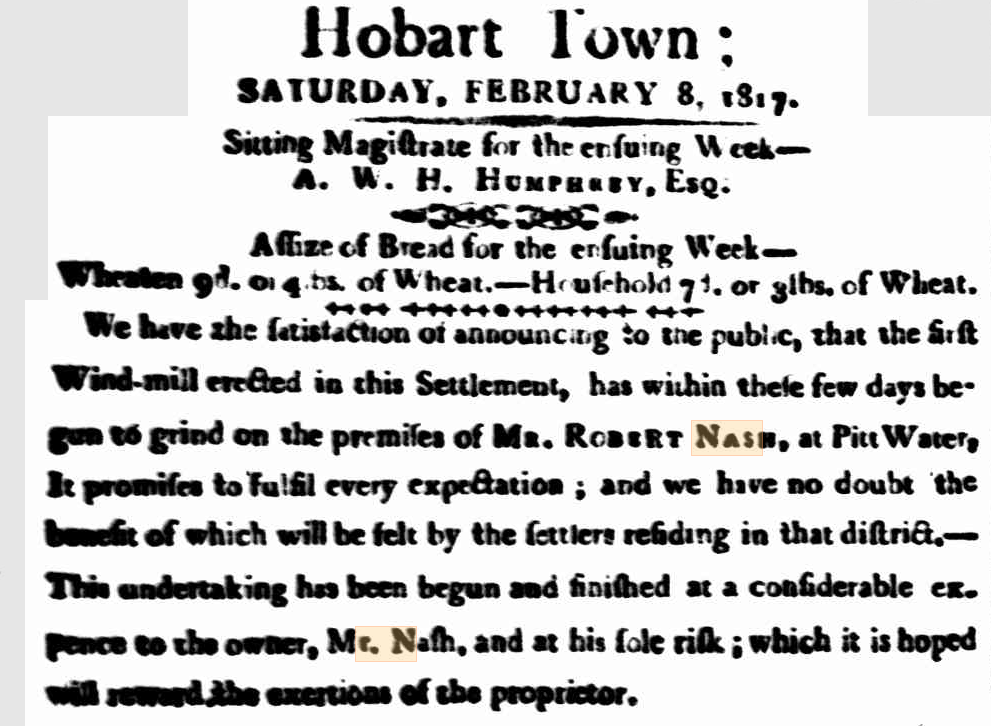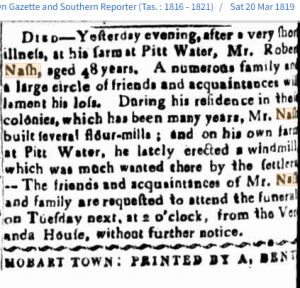If you were living in the Pitt Water area of the district of Richmond around 1815, you would have seen a windmill. Is this an image of Robert Nash’s original windmill or another built later in the century or maybe his original mill was removed and rebuilt after his death?
Robert Nash was the son of a millwright and born at Edenbridge in Kent, England in 1771. But at age 19 he stole some boots and shoes and was sent out to New South Wales in 1791 on the Albemarle as a convict. Before being sent to Norfolk Island, he married Ann Hannaway, who was also a convict from the Second Fleet. Ann already had three children and bore Robert four daughters while on Norfolk Island. Nash was very well behaved on the island, received a grant of land and an absolute pardon in 1800.
In 1808, Robert Nash and his family was one of many who departed Norfolk Island to settle in Hobart Town. Again he was given a grant of 10 acres near the New Town Rivulet where he built his first flour mill. This unfortunately was swept away in floods in 1809. In 1810 he built a second mill, this time on the Hobart Rivulet. More land was granted as the colony needed more wheat for its growing population. He received 200 acres near Pitt Water. He built a mill at his own expense in 1815. His land was south of the present day school and bounded by Sorell and Pittwater Rivulets.
By 1817 he was supplying the Hobart Town commissariat as one of its largest contractors. Robert also put an ad in the Hobart Town Gazette warning people who lit a fire in his paddocks to summon the ferry at Pitt Water to refrain from doing so until the end of the harvest.
Robert’s health suffered with all this hard work in the early colony and he died in 1819 at age 48.
Did his windmill survive? Or was it sold after his death to pay his debts. Edward Lord and James Lord were the principal creditors of Robert Nash’s estate. The windmill was still standing in February 1820 when Robert’s property went under the hammer at auction.
Robert’s mill in Liverpool Street, Hobart called the Old Mill was still in operation in June 1821 when Mr J A Motton opened it. It was owned by Walter Crammond. Cost for grinding was one shilling and threepence per bushel or 8lbs of wheat. The mill and acreage around it was again sold in 1824.
Update to this post:
Since mentioning this post on the Sorell Historical Society Facebook page, Karina Looby nee Newitt has added a photo of a replica of Nash’s Mill which can now be found in the Tasmanian Museum and Art Gallery TMAG. The replica was built by her father Alan Newitt, who had lived in the Blue Bell Inn.

Sources: Much of the early information was found in Robert Nash’s biography. Information about flour milling found in this thematic study.
Windmill images courtesy of Tasmanian Archives and Heritage Office, George Billing Collector – Windmill at Sorell –NS479/1/41 and NS479/1/42
Clicking on a blue link or image will open to the digitized document or book.
Readers: What do you know about the Nash family and flour milling in the district?




